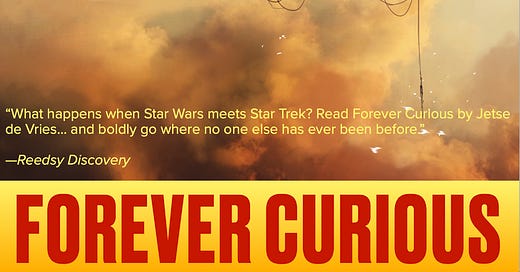
Na-Yeli traverses the fractal maze with newfound hope. She has a plan, she has mostly replenished her material stocks and recharged her batteries and—thank dog—has not been attacked by aliens. Yet, she adds silently. While this layer is smaller than the previous one, the trajectory she is forced to take is much longer. If no aggressive aliens will show up, she might even take a few breaks, now that she has appropriate landing gear. A small part of her hates to destroy even a minor part of all that crystalline, fractal-till-vanishing-point beauty, but it’s overruled by her practical part, the part that wants to survive.
The same practical part that programmed the autopilot in her computer implant to fly using the touch-the-wall rule. The same practical part that set up pattern-recognition algorithm that warns her when she passes terrain that has already been filmed. Even at the high resolution, they’re using—Na-Yeli, if anything, wants to be certain—it will take centuries before her DNA-structured quantum dot memory is full. And the same practical part of her that reconfigured her magnetic compass—worthless in this wild electromagnetic environment, anyway—into a locator of the highest static charges, the places where lightning is most likely to strike.
Now that her mind is free to observe, and to wander, Na-Yeli must guard herself against distractions. Her improvised lightning predictor steers her away from the biggest lightning strikes, and the Faraday cage of her exoskin can easily take the odd minor bolt of lightning. The place has an almost mesmerizing beauty, like a semi-opaque coral reef made of multi-colored glass, but without the fish. She almost regrets the lack of fauna—while wondering if these crystalline, fractal-to-the-point-of-no-return edifices could be considered flora—until she recalls her vehement dogfights. Still, there could be benign aliens, as well?
As if in answer, she sees a twinkling that seems active, moving as she steers around a large, tapered crystalline stalactite. A shimmering outline of a looking-glass cloud. The multitudes of colors in this glass prison are constantly changing as she moves through the maze—different angles of attack, different angles of reflection—and she’s been treated to so many refraction rainbows and diffraction prisms that they almost begin to look stale. But this is different, there is motion behind these color changes, almost as if there is a scintillating hint of life behind the twinkling. Possibly driven by the fact that the overall luminosity is never constant, always in flux.
She is tempted to investigate, very tempted. Does she dare lose the touch-to-the-wall, possibly negating all the progress she’s made? Or can she start anew, hoping this won’t take her back to where she came from? Then again, her pattern-recognition algorithm should warn her of that. Decisions, decisions.
Then the decision is taken out of her hand, as the glittering cloud is heading towards her. She’s almost blinded as a massive lightning bolt strikes it, no—strikes right through it—as the afterimage confirms. She doesn’t want to land, preferring to see this phenomenon from a higher vantage point. On top of that, while airborne she can get away faster if some kind of danger threatens her. So she settles into a figure-of-eight holding pattern, easier said than done in both the narrow crystalline canyons and the tempestuous atmosphere. But the sight is worth it, more than worth it.
The glittering cloud is a giant flock of—she can’t find a better word—butterflies. Their serrated wings are transparent and seem super thin. They seem so brittle, Na-Yeli thinks, yet their wings will cut like a molecular knife, I bet. Gossamer wings of glass so delicate they deserve their own nomenclature: glassamer? The Glassamer Butterflies, cutting an erratic flight path through the turbulent sky, seem to reflect the myriad colors of their environment in their own, delicate way. Or so it seems to Na-Yeli, who can’t quite take it all in.
Then, as they come closer, Na-Yeli can discern it. They’re not reflecting their environment like a twisted mirror, but each of them is displaying its own, colorful, ever-flowing pattern. One a living Mandelbrot gallery, zooming into brightly hued fractal patterns with no end in sight. Another features cyclonic swirls, hypnotic as primary colors fade into each other. A third meshes seemingly incompatible shapes into an Escherian tapestry. One even flashes a straightforward checkers pattern, with flowing colors: black-and-white, blue-and-yellow, grey-and-pink, red-and-green. Ongoing, in random order, as far as Na-Yeli can determine.
The more she studies them, the more it’s true: each Glassamer Butterfly has its own, unique pattern flow. Ever-branching leaves; entangled strings on acid like the curly hair of a dozen Medusa’s blowing in the wind; exuberantly blossoming flowers, petals, stamen, stigma, style, sepals, and all; exploding supernovae launching a never-ending stream of ejecta in a multitude of colors; watery waves in ever-changing interference patterns; crystal mountains rising through subduction forces, then crumbling to dust, reforged and rising again. She’s bedazzled, dazed, and confused.
Their unearthly beauty seems unreal. Why are they here? If beauty is an intrinsic quality of the true workings of nature, then the Glassamer Butterflies are one of its most magnificent manifestations. As they come closer, Na-Yeli changes her course to keep a certain distance. Not because she’s afraid of them, but because she’s afraid to hurt them. They seem so delicate, so brittle. I don’t want to be the glass hammer that destroys them, she thinks, the hypnotizing fragility of beauty.
It’s a miracle that they survive at all, in this wildly turbulent atmosphere. Glass birds or glass balloons would have been thrown against one of the phosphorescent stalagmites or one of the fluorescent stalactites in these tempestuous gales. Yet the Glassamer Butterflies proceed just fine in the lightning-laden madness. Their flight paths seem erratic, random, chaotic. For every movement forward they seem to make three sideways, two up and four down. Or suchlike.
And while they seem to come dangerously close to the protruding, hyper-fractalized branches of this crystalline forest, the intricate extensions of this fractal cage; they never collide with them. Quite probably, avoiding her will be trivial to them, yet Na-Yeli doesn’t want to put that to the test. She keeps her distance, films the wonderful creatures at the highest resolution of her cameras, taking in their sense of wonder with long, thirsty observations. LateralSys will love this, she knows, but the slow CEO, ever so reluctantly, returns to the mission.
She hasn’t strayed too far from the last touch-the-wall point and as her pattern-recognition software acknowledges that she’s back there, she continues with her trek through the maze. As she moves onwards, not meeting any threats or distractions, her mind wanders. How can this place be? How does it work? How can these stalactites hang down from above? What keeps the ceiling from falling?
The ongoing data stream from her improvised static charge locator—her old magnetic compass—gives a partial answer to her last question. While there are huge local variances—that catalyze the lightning strikes—on average both the upper and the lower crystalline edifices have a net negative charge. They repel each other, Na-Yeli thinks, but this opens up a whole different can of worms. How can a large environment like this have a net negative charge? Either charge conservation is wrong, or there’s something she isn’t seeing.
And all these hyper-fractalized branches, repeating patterns up to the atomic level: how do they grow? There is no flow of nutrients through those branches, as Na-Yeli would have seen that, transparent as they are. Even if some god-like intelligence had put them right there as they are, then the constant winds would have eroded them, and the ongoing lightning strikes should have left burn marks everywhere. Yet she sees only burn marks from static discharges that were recent, so recent she saw them happening before her eyes. And no signs of windswept erosion at all.
So these razor-sharp branches, both in the undergrowth and the upper foliage, must be replenished. But how? The whole sense of this layer defies her. What is it, this whole layer full of crystalline castles and fractalized forests? A giant computer of light? A chance structure arisen from the availability of the right materials at the right time? Then what powers it? Right now, the fool in her is asking more questions than the wise woman in her can answer.
—or—
Author’s note: an extended trip to Australia to witness the April 20 total spolar eclipse but a litle dent in my novel serialization schedule. I’ll be catching up over the next couple of weeks. Many thanks for your patience!








